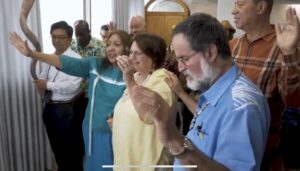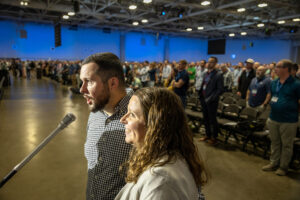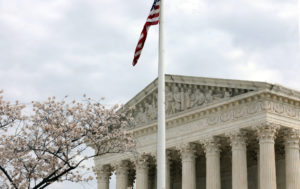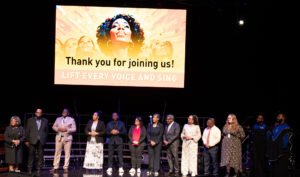
Most of us agree with John Maxwell’s well-known adage, “Leadership is influence, nothing more, nothing less.” By that definition, the pastor’s leadership influences the ministry of the local church. This is particularly true in building a culture of prayer. Your culture determines your future, so it cannot be left to chance.
A culture of prayer is never accidental. It has to be cultivated and nurtured for growth. It requires leadership. Here are 5 ways pastors can cultivate a prayer culture in the local church.
The pastor must be committed
It takes committed people to build a culture of prayer; but without the pastor’s “buy in,” it’s virtually impossible. If the lead pastor ignores a ministry, it suffers or even dies from neglect. If, on the other hand, the lead pastor believes in the prayer ministry, then time, attention, and resources are driven toward the prayer ministry; and it is given a greater chance for success.
For example, consider the Brooklyn Tabernacle in New York. In addition to the thousands of people who attend on Sundays, approximately 3000 people attend the Tuesday night prayer meeting every week.
The prayer ministry of the church even extends beyond the Brooklyn congregation. Ministry leaders from multiple faith backgrounds have benefited from Cymbala’s teaching on prayer, and the church is frequently held up as an example of what a “house of prayer” can look like in a modern context. But, if you read Cymbala’s book, Fresh Wind Fresh Fire, you learn the church was not a house of prayer until Cymbala led the church to pray. In other words, the culture of prayer grew as a direct result of the pastor’s passion and commitment. The same will be true anywhere you find a praying church. The pastor has to lead it.
Constant preaching and teaching on prayer
Is it any wonder that the Apostles devoted themselves to “prayer and to the ministry of the Word” (Acts 6:4)? Preaching Scripture is the primary tool we have in changing hearts and minds. As pastor Mike Bullmore accurately observed, “There’s so much at stake in our preaching. People’s lives are at stake. People are lost, alienated from God, and desperately in need of hearing the saving Word of Christ. The health of Christ’s church is at stake. God’s people desperately need instruction and encouragement from God’s Word.” Preaching Scripture on prayer (or any other subject) supernaturally transforms the people who hear it (Romans 10:17).
Any pastor who desires to cultivate a culture of prayer will take every opportunity to teach from one of the hundreds of passages on prayer found in Scripture. It is no exaggeration to say that the frequency to which the pastor preaches on prayer will be a barometer of the prayer culture in the congregation.
Provide prayer resources
The pastor will extend his influence by providing access to quality resources on prayer. Tell people which books on prayer you recommend. Post prayer articles and videos on your social media platforms. Give every new member who joins your church a copy of your favorite book on prayer.
In a few short years we have moved from the information age to the information revolution to the information society. If you’re looking for it, it’s out there. There is no shortage on prayer information, and more resources on prayer are readily available every day. The culture of prayer feeds on information and insight from godly communicators. Flood your congregation with access to the best resources.
Persevere in leading prayer – nothing comes easy
A staple in long family trips is the inevitable question from the back seat – “Are we there yet?” Like a long family trip, it’s easy to grow overly impatient when attempting to create a prayer culture in your church. But in many cases, you’re not simply creating a culture; you’re changing a preexisting culture. Your church already has a culture. Culture is the DNA of your group identity, and changing that culture will require your best efforts and constant persistence.
Let’s use Brooklyn Tabernacle as an example again. We may look at thousands of people at the prayer meeting and imagine leading something similar. But we may forget Jim Cymbala has been the pastor of the church since the early 1970s! He started transitioning the prayer culture of the church about 50 years ago, and the first prayer meeting he led, after announcing that God was leading him to focus on prayer, consisted of about a dozen people holding hands in a circle and praying for everything they could think of. It lasted 5 minutes! That’s a long way from the thousands who now pray for 2 hours every Tuesday. That’s just the point: It takes time to create a prayer culture, but it’s worth it.
So, the question is not: “How long will it take?” The question is: “How soon can we get started?” There is no finish line, only a starting gate.
Plan dynamic prayer meetings
Before His ascension, Jesus told the disciples to “wait in the city” (Luke 24:44). So, the disciples joined together in constant prayer for 10 days. Armin Gesswein studied that response and observed, “When Jesus ascended into heaven, the only thing He left behind was a prayer meeting!” How true. We will never create a fully formed culture of prayer until we embrace both private and congregational prayer.
Admittedly, we’ve all endured dull, lifeless, regularly scheduled church services erroneously called “prayer meetings.” They are so dead they bear no resemblance to the powerful, Spirit-filled gatherings we read about in the New Testament where fire fell, buildings shook, and thousands were saved. In fact, the difference is so significant most churches have stopped having prayer meetings.
Prayer meetings in many churches died for lack of a second! But those burdensome, poorly attended events were imposters, only posing as prayer meetings. It’s time to change them. It’s time to resurrect biblical prayer meetings full of passion and expectation. Prayer meetings change the world.
Most pastors want something better than the status quo related to prayer. They sense there’s more for their people and for themselves. A culture of prayer will never create itself. It waits on a leader to emerge to pay the price to develop it.
It’s waiting on you. What are you waiting on?














